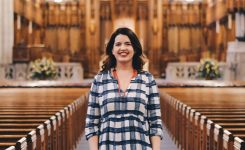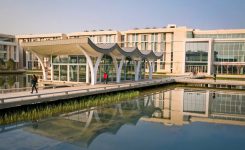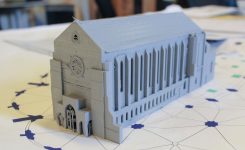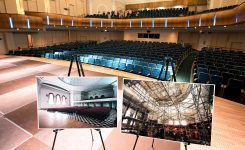Arts & Humanities
A Career in the Arts
A CAREER IN THE ARTS
Duke’s chief arts advocate reflects on 13 years of momentum
by Eric Ferreri
Scott Lindroth’s 13-year tenure as Duke’s first vice provost for the arts will soon conclude, which means the classically trained composer will have more time to bang on motorcycle engine cooling fins and other scrap metals to see what sounds they make.
Yes, you read that right.
A Duke faculty member for 30 years now, Lindroth has long had unusual and undefined musical ideas bouncing around in his head and little time to extract them. When his tenure as Duke’s chief advocate for the arts ends June 30, he will finally have time to pursue these barely-baked ideas that have teased and taunted him. A university committee is searching for his successor.
“I have projects that require a concentration and time I have not had. I’ve kept composing the whole time I’ve been vice provost, but not as productively,” he said one spring day in his new office in the Biddle music building on east campus. “My office is filled with scrap metal that I’ve experimented with over the years but have not yet managed to work into a real composition. The instruments I am most drawn to are a collection of motorcycle heads that have a fantastic variety of surfaces — especially the cooling fins – that resonate as clear pitches.”
He also has ideas about the sounds he can extract from knitting needles, chop sticks and even the clickety-clacking of typing on a laptop.
So yes, he has plans.
A native of Fond du Lac, Wisconsin, Lindroth grew up playing piano and saxophone in jazz and fusion bands before enrolling at the Eastman School of Music in Rochester, NY, where he received formal classical composition training. On the side, he worked as a composer and sound engineer at a local planetarium — his first paying gig. He earned $6.25 an hour.
He joined the Duke music faculty in 1990, and in 2007 became Duke’s first vice provost for the arts, just as the university was beginning to give the campus arts scene a significant push. He became the chief arts advocate during a stretch of unprecedented growth, playing a vital role in the expansion of the arts community as it moved from the physical and metaphorical periphery of campus to its center.
When he started the job, he already had 17 years of faculty experience behind him including a stint as a department chair, so he knew his arts colleagues needed more faculty lines, teaching assistants, equipment, teaching space and other core needs.
But he quickly realized his role would be far more broad. Looking back now, Lindroth reflects on the many relationships, partnerships and commitments needed to elevate the arts on campus — via investment in myriad ways. Here are excerpts of a recent conversation with Duke Today.
On making the arts something for everyone
“I realized that to have a credible arts initiative, there had to be campus-wide engagement with the arts. The faculty was working very hard to mentor students, make opportunities available, but we also knew there’s a large community of students on campus interested, passionate and talented in the arts but wouldn’t necessarily be taking classes in the arts. How do we get them? How do we engage them and create a community for them? That community didn’t really exist then, or it was incoherent. It existed in pockets. The unique geography of Duke made it hard; a lot of the arts are here on East Campus. Facilities are sprinkled all over the place. It was truly ad hoc in every way possible. Baldwin was a dilapidated auditorium on the most distant corner of campus.
So building the community was a challenge. That meant paying attention and engaging student activists in the arts. There was already a pretty good portfolio of student arts groups on campus. But leadership and students change each year so it’s hard to establish continuity.
Nevertheless that was an important constituency.
When we talked about campus culture, it was both with the academic departments but also outside of it. We partnered with the Nasher museum and Duke Performances, which became allies in this. The Nasher had a remarkable trajectory right out of the gate. And Duke Performances was a great collaborator.”
On the importance of bringing visiting artists to campus
“We established a visiting artist program and saw the arts departments were getting involved, but so were departments outside of the arts. Public policy wanted to bring in a political cartoonist. Neuroscience wanted to bring in a performance artist. This was all really cool.
It showed me that not only could we have a program that supported and enhanced our arts programs, it could make substantial impacts in other departments. That became a really neat lever for us to pull. There are great stories that come with those sorts of projects.
It became mission critical for all our presenters – the Nasher, Duke Performances and Center for Documentary Studies as well — that visiting artists play a role on campus. One of the first big ones, we brought in the painter Barkley Hendricks, who was coming off a very successful show at the Nasher, so he was here for six weeks in residence at Duke. He visited a couple dozen visual arts classes, worked with documentary studies and a lot of other stuff. He met with student organizations, he did public events, and he got work done. It was a win for everyone.
And then Duke Performances commissioned the jazz ensemble The Bad Plus to do a major work, their cover of Stravinsky’s Rite of Spring. That’s a pretty audacious thing to do. But we quickly realized that because of how they work, it would require a different kind of residency because we’d have to acclimate to each other. These are musicians who work in a totally improvisational mode. So we needed multiple engagements. The first meeting was a disaster. Our students imagined one thing, which was confusing to the band. But if you have three chances to meet them, you reach some common ground.
When the Bad Plus went into the studio and recorded student work, it was incredible. Educationally, that was so powerful. It allowed our students break new ground creatively.
So the idea of what we could do with artist residencies with multiple visits over the year, that was something Duke Performances very carefully cultivated. We did it a lot with music, but also with theater and dance.
Now, it’s something we use to recruit students into our program, and it’s something students count on. It’s another one of those situations where it’s a win all the way around.”
On providing truly distinct opportunities for students in the arts
“Without using the word ‘unique,’ I don’t know other institutions that engage visiting artists as deeply or with as much of a commitment as Duke does. These artists really play a crucial role in arts education here and helps us cultivate ties with the surrounding community. This is not hyperbole. And especially as we bring new graduate programs online it’s going to be even more important because visiting artist play a role in shaping professionally-minded students in those programs but also engaging with undergraduates.
It adds weight and significance. I’ve seen interactions with visiting artists just light people up.”
On the importance of better arts facilities
“One of the things we hoped to do when we established the vice provost of the arts was to build New Campus, which was supposed to go down Campus Drive. Departments, new dormitories, humanities programs were going to move there, it was a big deal. There was quite a bit of work. We even had physical models of what it would look like. And then the economic downturn hit and we shelved it.
But there had been some thinking about what might happen for arts facilities. We still wanted to do something for the arts, where art-making could happen at a high level. I remember (then-provost) Peter Lange asking me to do an inventory on the performing arts spaces on campus, tabulating their use and state of repair. That was part of the rationale to renovate Baldwin.
A Duke Endowment grant made it possible to renovate three landmark buildings including Baldwin. It went from a space nobody wanted to be in, to a mainstay for the music department and a community destination as well. It’s spectacular and shows what a difference a smart investment can make.
For the Ruby, we looked at programs thriving and programs struggling. We focused on the struggling programs, so we really invested in dance spaces. With the American Dance Festival here it seemed a smart investment and something that could be very distinctive for Duke. Our film program had ad hoc facilities that made it very difficult to teach, and yet students kept taking those courses. So we finally invested in a very good film theater and production facilities really designed for that program. And then let’s build more flexible facilities that can support many different art forms, like the von der Heyden Studio Theater, which can be a black box theater, it can present music, it can support exhibitions. It’s a shape-shifter.”
On The Ruby and what it means
“It signals literally a concrete commitment to the arts that the institution has made. It sends a message to the campus, community, to the faculty, to applicants and to our students. It’s so exciting to work with all of these people. It’s really gratifying. The thing about the building – I know it was confusing to the architects because they were accustomed to building facilities for specific uses. But we know students and artists live in these blurry lines between artistic practices and need a facility that accommodates that. It gives a center of gravity for the arts community to coalesce. Given the strange geography of Duke University, that cannot be overstated.
It’s really excited to see people come up with ways to use the Ruby that we did not anticipate. The Keith Carter photo exhibit hung from wires behind the building is one example. We originally thought about using the walls to display it. But they did it that way and it was fresh and cool and exciting. They hung photographs from trees! That kind of stuff is happening at the Ruby. We think of the Ruby as a blank canvas that can be filled in different ways.”
On new master's programs in documentary arts and dance
“We thought carefully about what a Duke MFA would be. You don’t go head to head with another MFA program in the same medium. How could we inflect it with something that reflects Duke’s values and opportunities? For us, it meant not cordoning the programs off. What I love about the Duke MFA programs is that the students want to be part of all of Duke. They want to take classes across the university. I love that. It is so Duke. I love that this is how you get ideas for your work. It shapes your creativity. You engage with knowledge across campus. You aren’t hermetically sealed in this arts bubble. That’s powerful. I can’t say I had a shaping role in how those programs came into being, but I’m very proud that becomes part of their identity. It helps to define Duke.”
On surprises
“I was surprised and delighted by just how interested and eager to participate in the arts people all over campus are. It somehow speaks to our most idealistic inner voices. The arts means a lot to people and I’m continually surprised and happy to see that. It lets us think all the time about new classes and visiting artists and new events we might take on.”
On the future, and challenges
“One challenge of the job is translation. Valuing and respecting the jobs my colleagues are doing in the departments but also translating it to external audiences. Whether it’s something in a press release, or cultivating philanthropy in the arts. We’re a university; our business is education and research. What strikes me, and I love this in a way, when I meet with alumni considering donating, they’re most interested in how the arts changes and impacts students’ lives. That’s a really useful exercise I think. It makes us remember what the larger mission is here, what brings us all together.”
Design by Caroline Pate
Photo and Video by Julie Schoonmaker, Bill Snead, Jared Lazarus and Megan Mendenhall
More Arts at Duke











